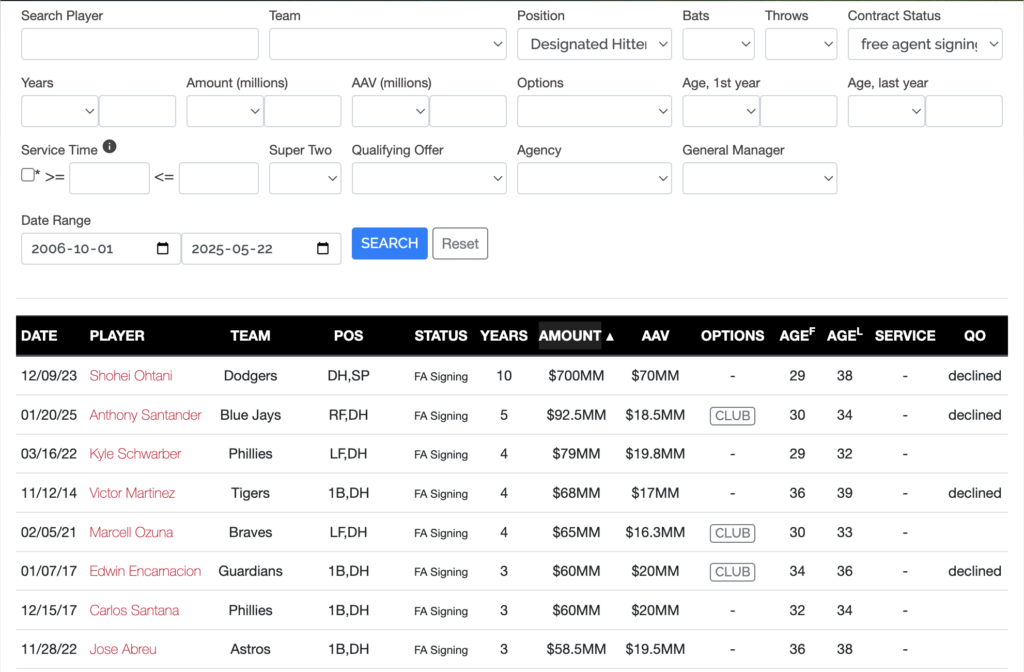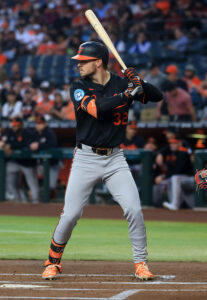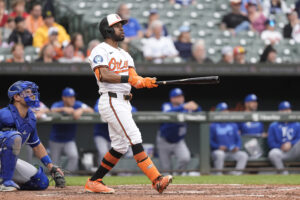Designated hitter Kyle Schwarber is slated for free agency at the end of this season. Recently, a couple of different writers have floated a rough $100MM figure as a possibility for his next contract. On May 6th, Jeff Passan of ESPN published a column where he described Schwarber getting to $25MM annually over a four-year deal as “eminently reasonable.” About a week later, Scott Lauber of the Philadelphia Inquirer wrote that Schwarber’s recent performance might “lead to the $100 million contract” which previously eluded him.
While Passan did conclude that nine figures is “reasonable” for Schwarber, he is aware that it would set a new precedent. He writes that “a designated hitter who’s going to be 33 next Opening Day getting a nine-figure deal” would be an “outlier” but believes that Schwarber is himself an outlier and deserving of a contract that breaks the mold.
This post will dig in on those current precedents to see how far Schwarber would have to push the market in order to hit the century mark, with the help of MLBTR’s Contract Tracker.
This image (link for app users) shows all the free agent deals for designated hitters going back almost 20 years, sorted by total guarantee. As you can see, designated hitters have not been paid $25MM annually, nor have any received a $100MM guarantee.
Shohei Ohtani is out on an island here, for obvious reasons. He’s a unicorn in terms of on-field ability as a two-way player and his international stardom is unparalleled. No one else has topped $20MM annually. Anthony Santander came close to the century mark in terms of total sticker price but his $92.5MM deal had notable deferrals which pushed the net present value closer to the $70MM range. He’s also not a strict DH, having logged over 1,000 innings in the outfield for the Orioles last year.
Next on the list is Schwarber himself. The last time he hit the open market, he was going into his age-29 season, yet he could only get $79MM over four years, an AAV just under $20MM. Inflation usually pushes the market forward but somewhat similar players like Joc Pederson and Santander could only get to $18.5MM annually in the most recent offseason.
Schwarber is better than those guys, but let’s also look at the age question. Here are all free agent contracts for hitters starting at age-33 or older, regardless of position.
In this image (link for app users), we can see that no free-agent hitter has received a $100MM guarantee beginning at age 33, nor have any secured a $25MM annual salary beginning at that age. Another path to $100MM would be to get $20MM annually over five years. But as shown in that image, there have been no recent deals of that length for players in this age category.
Josh Donaldson did come close to the $25MM AAV and $100MM total. But at the time of that deal, he was still an above-average third baseman. He had just hit 37 home runs for Atlanta while being credited with ten Defensive Runs Saved and nine Outs Above Average. He continued playing well through the first half of that deal but was subpar at the plate in the final two years.
As for Starling Marte, his 2021 season saw him post a 132 wRC+, play over 1,000 innings in the outfield, and steal 47 bases in just 120 games. Still, he was limited to four years and an AAV just under $20MM.
So, designated hitters don’t get $100MM contracts. Nor do players pushing into their mid-30s. For Schwarber to get $100MM as a 33-year-old DH, some team would have to consider him to be worth significantly more than any other previous player in those categories. In fact, 33-year-old Schwarber would have to be valued higher than 29-year-old Schwarber.
What Schwarber has working for him is that he has found a new gear at the plate since coming to Philadelphia. Since signing that deal with the Phils, he has hit 148 home runs. He has drawn walks at a 15.4% clip. His 28.7% strikeout rate is high but he’s always been in that range. Overall, he has a .224/.348/.496 line and 131 wRC+ for the Phillies. Only Aaron Judge and Ohtani have hit more home runs in that time. Judge and Juan Soto are the only guys ahead of him in terms of walk rate, while the wRC+ number is 11th for hitters with at least 2,000 plate appearances in that span. This year, Schwarber’s even above his own pace, with 17 home runs already, a .253/.390/.573 line and 164 wRC+.
Prior to coming to Philadelphia, he had been a few notches below that. From 2017 to 2019, he slashed .234/.337/.492 for a 113 wRC+ with the Cubs. His 12.9% walk rate was good but a few ticks below what the pace he has subsequently managed in Philly. Similarly, he hit 94 home runs over those three seasons, a pace of just over 30 annually. That’s very good, but he’s pushed that up to an almost 45-homer annual pace with the Phils.
He then had a dip in the shortened 2020 campaign. He did hit 11 home runs but his .188/.308/.393 line led to a 91 wRC+. The Cubs could have retained him for 2021 with a projected arbitration salary in the $8-10MM range, but they decided to move on instead. He bounced back tremendously in 2021, splitting his time between the Nationals and Red Sox. He signed a $10MM deal with Washington and was traded to Boston at the deadline. He hit 32 home runs and put up a .266/.374/.554 line for a 145 wRC+.
It’s possible that his rough 2020 showing was still fresh in the minds of baseball decision makers and hampered his market the last time he was a free agent. Since then, he has shown himself to be incredibly reliable at the plate, erasing the memory of his non-tender.
The question now is whether teams will think he can keep it going. When he signed his last contract, he was still a somewhat viable fielder. He has never been good in left field but nonetheless was a regular out there prior to signing with the Phils and got roughly 1,000 innings on the grass in both 2022 and 2023. He has become almost exclusively a DH more recently, with just 41 innings in the field in 2024 and 36 so far in 2025. That means he’ll need to keep hitting to provide any value.
Even the most talented players are subject to declining performance in their mid-30s. Donaldson and Marte were performing well on both sides of the ball in their platform years, but Marte has essentially been a replacement-level player starting with his age-34 season. Donaldson’s bat fell below league average in his age-36 campaign. José Abreu was the A.L. MVP in his age-33 season but was unplayable by his age-36 season.
That could leave Schwarber with a few good years to go. Perhaps not playing the field will help him to gracefully descend that aging curve. Looking at some of the names above, Edwin Encarnación had 34 home runs and a 130 wRC+ in his age-36 season. Victor Martinez had 32 bombs and a 168 wRC+ in his age-35 campaign. He followed that up with a nightmare season, 11 homers and a 77 wRC+, but was able to bounce back with a solid campaign at the age of 37 that features 27 long balls and a 120 wRC+.
Santander just hit 44 home runs last year and still couldn’t get to nine figures, even though he was going into his age-30 season. However, he has never had strong walk rates, so his overall offensive profile is less than Schwarber’s. Even with those bombs, he only had a 129 wRC+ last year, his best such mark in a full season. Schwarber’s average production over three-plus years in Philadelphia has been better than that, with a big spike here in 2025.
Pederson put up a 151 wRC+ last year but was mostly shielded from lefties. He has a .209/.305/.328 line and 78 wRC+ against southpaws in his career. Schwarber had some platoon issues earlier in his career but seems to have put those behind him. At the time of signing his deal with the Phillies, he had a .214/.324/.361 line and 86 wRC+ without the platoon advantage. Since coming to Philly, he has a .235/.357/.468 line and 130 wRC+. Amazingly, his wRC+ against lefties has been growing year over year: 95 in 2022, then 107 in 2023, 153 last year and a shocking 223 so far in 2025. That could certainly be an argument for Schwarber doing better than he did on his last deal.
It’s also perhaps worth noting that lowering the age cut-off by one year opens up another interesting comp from recent years. While Donaldson’s $92MM deal is the top mark for a 33-year-old, Freddie Freeman got a six-year $162MM deal going into his age-32 campaign. He’s a better overall hitter than Schwarber with a career 143 wRC+. He’s also a first baseman and not limited to the DH spot. Those factors and the one-year age difference are arguments for Schwarber coming in below Freeman, but it’s possible for him to do so and hit the century mark.
Another factor to consider is the qualifying offer, as Schwarber has never received one. Since he was traded in 2021, he wasn’t eligible to get a QO prior to signing with the Phils. If he sticks in Philadelphia all season long and keeps producing like this, they would surely issue him one, which would probably be in the range of $22MM or so.
Would a team be willing to make a four-year, nine-figure bet on a 33-year-old DH and give up a draft pick in the process? It’s never happened before. Time will tell if Schwarber is unique enough to set some new benchmarks.
Photo courtesy of Bill Streicher, Imagn Images







